
Diesel Duck
26 July 2013 | On board Diesel Duck
26 July 2013 | Leamington, Canada
25 April 2013 | Florida
26 March 2013 | Florida
27 February 2013 | Stuart, Florida
10 February 2013 | Beautiful Florida
24 January 2013 | Key West, Florida
26 December 2012 | Miami Beach
07 December 2012 | Miami Beach
27 November 2012 | Stuart, Florida
15 November 2012 | Wrightville Beach, NC
05 November 2012 | Chesapeake City, MD
01 November 2012 | New York, NY
30 October 2012 | Half Moon Bay Marina
29 October 2012 | Croton-on-Hudson, NY
23 October 2012 | The New York State Canal System
14 August 2012 | Leamington, Canada
20 June 2012 | Leamington, Ontario
20 June 2012 | Leamington, Ontario
13 May 2012 | In the Erie Canal System
Battery and 12 VDC power talk #2
05 January 2012 | Bimini, Bahamas
Benno
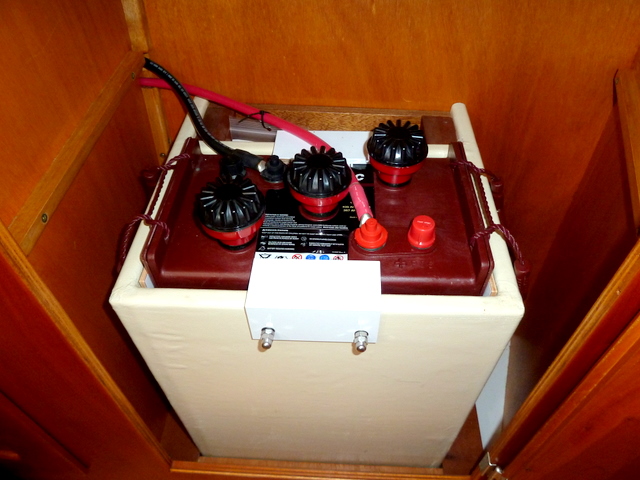
Picture: a Wet Cell deep cycle Trojan L16H battery of Diesel Duck's house bank. Please notice the Hydrocaps.
In the previous write-up, I wrote about the 12 volt stuff in general and left off with an explanation of the 12 VDC starter bank. Before I write about the house bank, I'd like to touch first the different battery types used on a boat for the house and the starter bank: a.) Wet Cell battery - b.) Gel battery - c.) AGM battery - d.) Lithium Ion battery!
a.)
1. Wet Cell battery 12 volt DC (VDC) for short time power burst in starter application
2. Wet Cell deep cycle battery 12 VDC for a long time storage of 12 volt DC power to run all day as a house bank on a boat or RV, maybe on a forklift truck or a floor sweeper in commercial application.
1. and 2. are the second oldest type of batteries in use, invented 1859 by a French physicist Gaston Planté and consist at the present time of lead antimony plates submerged in sulfuric acid electrolyte contained in a strong plastic housing with 6 cells (each providing 2 VDC) and vent caps on the top to let the generated gas escape when they are being charged and these caps permit the service expert during maintenance to add or replace the electrolyte or for you to water the battery.
A wet cell starter battery has no place on a boat (explained in the first write-up). The use of a wet cell starter battery should be left to the automotive and heavy equipment market where this type of battery still serves a purpose. A wet cell deep cycle storage battery still has its use in a house bank battery on many boats or RVs. Our "Diesel Duck", as an example, has a 950 amp wet cell deep cycle house bank. Today there are better batteries on the market and I would go now a different route when buying batteries for a house bank (more about that further down on this write-up) Wet cell batteries, starter or deep cycled are high maintenance batteries. They need to be watered frequently and at least need to be equalized twice a year. I will explain watering and equalizing further down. These batteries must be mounted well aired. One of the biggest handicaps is the problem of slow discharging to nil, which occurs when you store the boat for a longer period of time. Wet cell batteries will discharge even if every power consumer is switched off incl. the parasitic load like some hardwired inverters, where the display is alive (these buggers can be a 1 amp parasitic load an hour). Wet cell batteries can discharge up to 20% a month (depending on their age), when no charge is applied. There is no guaranty from the boatyard where your boat is stored on the hard, that the power cord to your boat will not be disconnected and your plugged in charger can keep your batteries charged up. A tropical downpour can shorten out the power cord or the other friendly guy is using it for a drill or grinder with the good intension to plug it back into your boat, but he forgets.
You get back to the boat and discover that your house bank is totally discharged and toast. You need new batteries then. Total discharged wet well batteries cannot be recharged. Gel and AGM batteries can be recharged with no problem by a smart charger.
Watering:
The lead plates in each wet cell are submerged in electrolyte up to the top of the plates and then are being topped up with distilled or ionized water just to 1/8 inch underneath the filler neck of the vent cap opening. This water mixes itself with the electrolyte and evaporates during the charging process by turning into hydrogen gas. There is a device on the market and it is called Hydrocap. These Hydrocaps are filled with a mineral and this mineral will convert the hydrogen gas back into water and this water drips back down into the battery cell. But still in a certain time period the battery will lose some water and you have to replace it. A very important point is, you first recharge the wet cell batteries to a full charge between 12.6 VDC and 12.8 VDC before you remove the vent caps and do the maintenance watering. This is extremely important, so please remember this. Also, please never use ordinary tap water for watering batteries. You have to purchase distilled or ionized water. Both are widely available at supermarkets or at gas stations. To water the battery, remove the vent caps or Hydrocaps, look at the water level. The water level should be up to 1/8 inch below the filler neck. If it is below this level add more water with a measuring cup to bring the water up to the 1/8 inch level below the filler neck. Do not overfill, the mixed water and electrolyte will spill when the boat is healing over by wave or wind action. That stuff is very corrosive. Fit the vent caps back!
Equalizing:
During the slow discharging process while the batteries are working in providing you with power to run your 12 VDC equipments like fridge and freezer, watching TV and having the inverter running for 120 volt etc, the batteries will sulfate a little and build crystals on the lead plates. This process is a normal occurrence and over a certain time period, these plates will pack up with crystals resulting that the batteries get handicapped and the charge holding capacity is reduced. To counteract this, there is a process and this is called equalizing.
Equalizing a battery is the controlled boiling of the electrolyte with a high voltage charge to remove lead sulfate crystals which have collected on the lead plates inside of the battery. You may do this every 6 months, but your battery charger must have a setting for equalization. The best time for equalization is when your batteries are discharged and you have access to shore power or a generator. Removed the vent caps or Hydrocaps. During the equalization the batteries get hot, produce a lot of hydrogen gas and acid mist, this mist damage surrounding surfaces. This means you have to keep all doors, hatches and ports wide open for a good breeze inside your boat. Hydrogen gas is explosive, so don't smoke, shut the galley down and give the chef a few hours off. No flames! Shut every 12 volt system down and start your charger, select the equalization program and equalize for not more than 2 hours. After 2 hours switch the charger off and let the batteries rest for at least a 1/2 hour. (Now you could use a hydrometer and test each battery cell and check the specific gravity of the electrolyte, knowing then the condition of your battery or even find out that you have a bad cell and have to replace the battery. This will add more misery to your daily financial burden) Your batteries are now fully charged and you have to check the water level. During the equalizing process their was some loss of water, which you have to replace now. After done this, close the cell openings with the vent or Hydrocaps. Turn your battery switch back on!
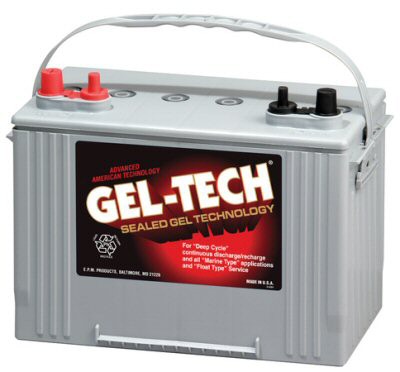
Picture is: Diesel Duck's old Gel starter bank battery.
b.)
Gel battery:
These batteries are a good choice for a boat owner. They don't gas and they are totally maintenance free. This type of battery was pioneered by the Sonnenschein Company in Berlin, Germany at the end of the seventies, which is now owned by Exide, USA. Gel batteries can serve as a starter battery and limited as a house bank battery. Even when completely discharged (this would kill wet cell batteries), Gel batteries can be recharged without damage to the batteries. One thing, which would kill Gel batteries and could make them dangerous, is a higher than 14.1 VDC charger voltage, it will build up a gas pressure, pop the safety valve, release the gas and that gas can explode. An off the mill automotive battery charger should not be used. Any smart charger where you can select the battery type is the one and only choice of charger to charge Gel batteries. Why called Gel batteries? The electrolyte is gelled with silica dust into a paste and in addition lead - calcium plates replacing the in a wet cell battery used lead-antimony plates. Diesel Duck has used Gel starter batteries for 12 years without any problem. They got fully discharged during a storage time and after recharging in 2005, they served us well. The Gel technology is over 30 years old and like everything else, this technology is replaced by a newer and better one as time moves on.
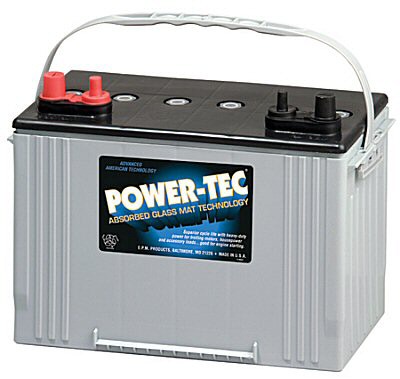
Picture is: Diesel Duck's new AGM starter bank battery
c.)
AGM battery:
Now this is an even better choice for the boat owner. Maybe at the present time the best choice. AGM stands for absorbed glass mat battery and they are different to Gel batteries. The electrolyte is not gelled, instead absorbed into boron silica fiberglass mats which are wrapped around specially ratio lead-calcium plates and hermetically sealed into the celled plastic housing. The technology was developed 1985 for military aircraft, but the first AGM cell was patented by the Gates Rubber Corp. in 1972. AGM batteries can have flat or spiral form rolled lead-calcium plates. They are totally maintenance free, can be mounted in any position and charged by any off the mill automotive charger. Of course this is not recommended. AGMs are dual purpose batteries and can serve as starter and storage batteries. Good as starter bank or house bank so to speak. To charge this type of battery I would use a smart charger, an alternator with a smart regulator, or, if you have a large solar panel array, a smart solar controller. AGM batteries don't like being overcharged, which is similar to gel batteries. During longtime storage, AGM batteries loose only 2 - 3% a month of their charge, a very important factor for the seasonal boater.
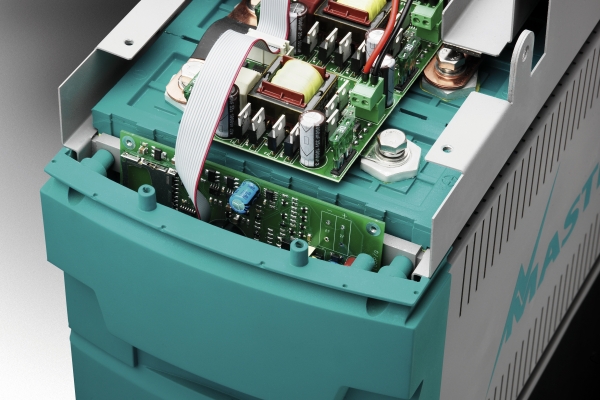
12 VDC Lithium Ion battery. Picture by Mastervolt. NE
d.)
Lithium Ion battery:
This is the new kid on the block. I have seen only one Polish built Catamaran in Panama with these batteries. Like in laptops, iPhones and cameras, this technology is creeping into the marine market. These batteries weight a lot less than their lead cousins and present a weight saving for the racing sailor. Most of these new technology marine batteries need a special lithium ion smart charger to charge them up. The Dutch company Mastervolt has pioneered a special 320 amp 12 VDC lithium ion battery for the marine market. These batteries have built-in pc-boards which enables the boat owner to use a normal smart charger to charge the lithium ion batteries. You have to keep an eye on this new marine technology, but for now hold on to your wallet.
In the next write-up is the House Bank on the plate.
In the previous write-up, I wrote about the 12 volt stuff in general and left off with an explanation of the 12 VDC starter bank. Before I write about the house bank, I'd like to touch first the different battery types used on a boat for the house and the starter bank: a.) Wet Cell battery - b.) Gel battery - c.) AGM battery - d.) Lithium Ion battery!
a.)
1. Wet Cell battery 12 volt DC (VDC) for short time power burst in starter application
2. Wet Cell deep cycle battery 12 VDC for a long time storage of 12 volt DC power to run all day as a house bank on a boat or RV, maybe on a forklift truck or a floor sweeper in commercial application.
1. and 2. are the second oldest type of batteries in use, invented 1859 by a French physicist Gaston Planté and consist at the present time of lead antimony plates submerged in sulfuric acid electrolyte contained in a strong plastic housing with 6 cells (each providing 2 VDC) and vent caps on the top to let the generated gas escape when they are being charged and these caps permit the service expert during maintenance to add or replace the electrolyte or for you to water the battery.
A wet cell starter battery has no place on a boat (explained in the first write-up). The use of a wet cell starter battery should be left to the automotive and heavy equipment market where this type of battery still serves a purpose. A wet cell deep cycle storage battery still has its use in a house bank battery on many boats or RVs. Our "Diesel Duck", as an example, has a 950 amp wet cell deep cycle house bank. Today there are better batteries on the market and I would go now a different route when buying batteries for a house bank (more about that further down on this write-up) Wet cell batteries, starter or deep cycled are high maintenance batteries. They need to be watered frequently and at least need to be equalized twice a year. I will explain watering and equalizing further down. These batteries must be mounted well aired. One of the biggest handicaps is the problem of slow discharging to nil, which occurs when you store the boat for a longer period of time. Wet cell batteries will discharge even if every power consumer is switched off incl. the parasitic load like some hardwired inverters, where the display is alive (these buggers can be a 1 amp parasitic load an hour). Wet cell batteries can discharge up to 20% a month (depending on their age), when no charge is applied. There is no guaranty from the boatyard where your boat is stored on the hard, that the power cord to your boat will not be disconnected and your plugged in charger can keep your batteries charged up. A tropical downpour can shorten out the power cord or the other friendly guy is using it for a drill or grinder with the good intension to plug it back into your boat, but he forgets.
You get back to the boat and discover that your house bank is totally discharged and toast. You need new batteries then. Total discharged wet well batteries cannot be recharged. Gel and AGM batteries can be recharged with no problem by a smart charger.
Watering:
The lead plates in each wet cell are submerged in electrolyte up to the top of the plates and then are being topped up with distilled or ionized water just to 1/8 inch underneath the filler neck of the vent cap opening. This water mixes itself with the electrolyte and evaporates during the charging process by turning into hydrogen gas. There is a device on the market and it is called Hydrocap. These Hydrocaps are filled with a mineral and this mineral will convert the hydrogen gas back into water and this water drips back down into the battery cell. But still in a certain time period the battery will lose some water and you have to replace it. A very important point is, you first recharge the wet cell batteries to a full charge between 12.6 VDC and 12.8 VDC before you remove the vent caps and do the maintenance watering. This is extremely important, so please remember this. Also, please never use ordinary tap water for watering batteries. You have to purchase distilled or ionized water. Both are widely available at supermarkets or at gas stations. To water the battery, remove the vent caps or Hydrocaps, look at the water level. The water level should be up to 1/8 inch below the filler neck. If it is below this level add more water with a measuring cup to bring the water up to the 1/8 inch level below the filler neck. Do not overfill, the mixed water and electrolyte will spill when the boat is healing over by wave or wind action. That stuff is very corrosive. Fit the vent caps back!
Equalizing:
During the slow discharging process while the batteries are working in providing you with power to run your 12 VDC equipments like fridge and freezer, watching TV and having the inverter running for 120 volt etc, the batteries will sulfate a little and build crystals on the lead plates. This process is a normal occurrence and over a certain time period, these plates will pack up with crystals resulting that the batteries get handicapped and the charge holding capacity is reduced. To counteract this, there is a process and this is called equalizing.
Equalizing a battery is the controlled boiling of the electrolyte with a high voltage charge to remove lead sulfate crystals which have collected on the lead plates inside of the battery. You may do this every 6 months, but your battery charger must have a setting for equalization. The best time for equalization is when your batteries are discharged and you have access to shore power or a generator. Removed the vent caps or Hydrocaps. During the equalization the batteries get hot, produce a lot of hydrogen gas and acid mist, this mist damage surrounding surfaces. This means you have to keep all doors, hatches and ports wide open for a good breeze inside your boat. Hydrogen gas is explosive, so don't smoke, shut the galley down and give the chef a few hours off. No flames! Shut every 12 volt system down and start your charger, select the equalization program and equalize for not more than 2 hours. After 2 hours switch the charger off and let the batteries rest for at least a 1/2 hour. (Now you could use a hydrometer and test each battery cell and check the specific gravity of the electrolyte, knowing then the condition of your battery or even find out that you have a bad cell and have to replace the battery. This will add more misery to your daily financial burden) Your batteries are now fully charged and you have to check the water level. During the equalizing process their was some loss of water, which you have to replace now. After done this, close the cell openings with the vent or Hydrocaps. Turn your battery switch back on!

Picture is: Diesel Duck's old Gel starter bank battery.
b.)
Gel battery:
These batteries are a good choice for a boat owner. They don't gas and they are totally maintenance free. This type of battery was pioneered by the Sonnenschein Company in Berlin, Germany at the end of the seventies, which is now owned by Exide, USA. Gel batteries can serve as a starter battery and limited as a house bank battery. Even when completely discharged (this would kill wet cell batteries), Gel batteries can be recharged without damage to the batteries. One thing, which would kill Gel batteries and could make them dangerous, is a higher than 14.1 VDC charger voltage, it will build up a gas pressure, pop the safety valve, release the gas and that gas can explode. An off the mill automotive battery charger should not be used. Any smart charger where you can select the battery type is the one and only choice of charger to charge Gel batteries. Why called Gel batteries? The electrolyte is gelled with silica dust into a paste and in addition lead - calcium plates replacing the in a wet cell battery used lead-antimony plates. Diesel Duck has used Gel starter batteries for 12 years without any problem. They got fully discharged during a storage time and after recharging in 2005, they served us well. The Gel technology is over 30 years old and like everything else, this technology is replaced by a newer and better one as time moves on.

Picture is: Diesel Duck's new AGM starter bank battery
c.)
AGM battery:
Now this is an even better choice for the boat owner. Maybe at the present time the best choice. AGM stands for absorbed glass mat battery and they are different to Gel batteries. The electrolyte is not gelled, instead absorbed into boron silica fiberglass mats which are wrapped around specially ratio lead-calcium plates and hermetically sealed into the celled plastic housing. The technology was developed 1985 for military aircraft, but the first AGM cell was patented by the Gates Rubber Corp. in 1972. AGM batteries can have flat or spiral form rolled lead-calcium plates. They are totally maintenance free, can be mounted in any position and charged by any off the mill automotive charger. Of course this is not recommended. AGMs are dual purpose batteries and can serve as starter and storage batteries. Good as starter bank or house bank so to speak. To charge this type of battery I would use a smart charger, an alternator with a smart regulator, or, if you have a large solar panel array, a smart solar controller. AGM batteries don't like being overcharged, which is similar to gel batteries. During longtime storage, AGM batteries loose only 2 - 3% a month of their charge, a very important factor for the seasonal boater.

12 VDC Lithium Ion battery. Picture by Mastervolt. NE
d.)
Lithium Ion battery:
This is the new kid on the block. I have seen only one Polish built Catamaran in Panama with these batteries. Like in laptops, iPhones and cameras, this technology is creeping into the marine market. These batteries weight a lot less than their lead cousins and present a weight saving for the racing sailor. Most of these new technology marine batteries need a special lithium ion smart charger to charge them up. The Dutch company Mastervolt has pioneered a special 320 amp 12 VDC lithium ion battery for the marine market. These batteries have built-in pc-boards which enables the boat owner to use a normal smart charger to charge the lithium ion batteries. You have to keep an eye on this new marine technology, but for now hold on to your wallet.
In the next write-up is the House Bank on the plate.
Comments
| Vessel Name: | Diesel Duck |
| Vessel Make/Model: | Diesel Duck 41' - Aluminum |
| Hailing Port: | Toronto, Canada |
| Crew: | Marlene and Benno Klopfer (Photo by Marcie Lynn, Puerto Montt, Chile) |
| About: | |
| Extra: | |
| Home Page: | http://www.sailblogs.com/member/dieselduck |
| Social: |
Gallery not available
Cruising on a Troller Yacht
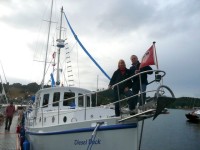
Who: Marlene and Benno Klopfer (Photo by Marcie Lynn, Puerto Montt, Chile)
Port: Toronto, Canada



